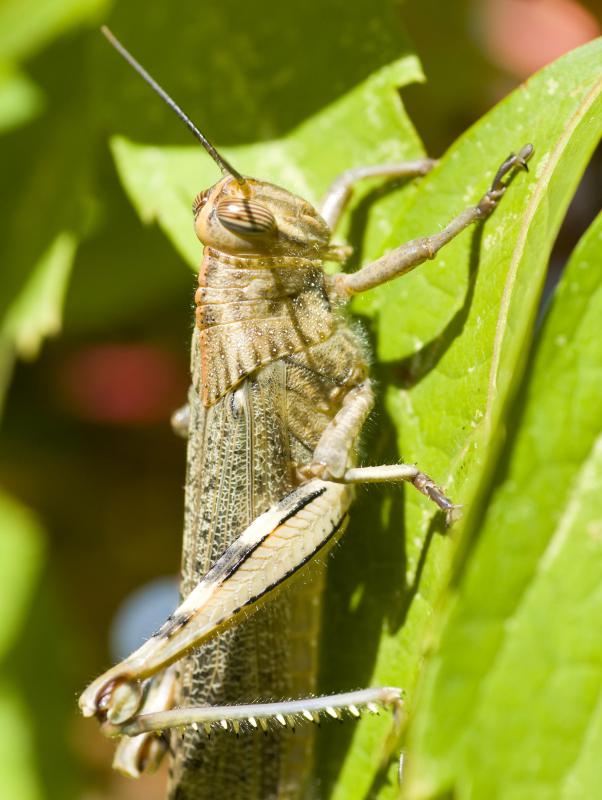At AllThingsNature, we're committed to delivering accurate, trustworthy information. Our expert-authored content is rigorously fact-checked and sourced from credible authorities. Discover how we uphold the highest standards in providing you with reliable knowledge.
What is a Blue Crane?
A blue crane, also known as a paradise crane or Stanley crane, is one of the smaller members of the crane species. Blue cranes are 40 to 47 inches (1 to 1.2 m) tall, are about 50 inches (127 cm) long, have a wingspan of approximately 60 inches (152 cm) and weigh 8.8 to 13.6 pounds (4 to 6.2 kg). The blue crane has a distinctive coloration: Its body is a pale blue-gray, and it has a pink bill, a white crown and dark-gray wingtip feathers which are so long they almost reach the ground. Males and females of this type of crane have the same markings, but the male has a bill that is a little longer.
Blue cranes like to live in grasslands that are both open and arid or on plains where there are low bushes that are shrubby. Often, they also can be found in pasture and agricultural areas. In addition, the blue crane will feed and roost in shallow wetlands, where they are available.

The blue crane mainly eats plant material, including small bulbs, roots, tubers and the seeds of grasses and sedges. It is an omnivore, so it also will feed on several kinds of animal life. Blue cranes are partial to insects such as caterpillars and locusts as well as crabs, fish, reptiles and small mammals.
Geographically, the blue crane is found only in southern Africa. Almost all blue cranes live within the boundaries of the country of South Africa, and it is that country’s national bird. Less than 1 percent of blue cranes live elsewhere, and those are in very small, isolated populations in western Swaziland and northern Namibia. This species of crane migrates only locally. It spends the summer breeding season in grasslands at higher elevations and moves to lower elevations with its chicks in the fall and winter.

A pair of mated blue cranes will produce only a single brood of two eggs during breeding season. Blue cranes like to nest in isolated grasslands where the eggs will be laid either on the bare ground or in the middle of the grass. The eggs are incubated by both parents for approximately 30 days. After they have hatched, the chicks are cared for by both parents for 85 or more days, until their first flight. After that, the male becomes the protector, and the female nurtures the young birds.
Frequently Asked Questions
What is a Blue Crane?
The Blue Crane, also known as the Paradise Crane or Anthropoides paradiseus, is a tall bird native to southern Africa. It's distinguished by its pale blue-gray plumage and elongated feathers drooping from the nape, which give it a distinctive appearance. The species is revered in South Africa, where it's considered a national symbol and is protected by law.
Where can Blue Cranes be found in the wild?
Blue Cranes are predominantly found in the grasslands of South Africa, with smaller populations in Namibia and Lesotho. They prefer dry grasslands, agricultural fields, and sometimes wetlands. According to the International Crane Foundation, the majority of the world's Blue Cranes reside in South Africa, with an estimated population of around 25,000 individuals.
What do Blue Cranes eat?
Blue Cranes are omnivorous birds with a diet that includes both plant and animal matter. They feed on a variety of items such as insects, reptiles, small mammals, seeds, and grains. Their foraging behavior involves walking through their habitat and picking food items off the ground or from low vegetation.
Are Blue Cranes endangered?
Yes, Blue Cranes are considered vulnerable to extinction. Their populations have been declining due to habitat loss, human disturbance, and poisoning from agricultural pesticides. Conservation efforts are in place to protect their habitats and mitigate threats. The IUCN Red List categorizes them as "Vulnerable," highlighting the need for ongoing conservation measures.
How do Blue Cranes reproduce?
Blue Cranes are monogamous birds that form lifelong pairs. During the breeding season, they perform elaborate dances to strengthen pair bonds. They typically lay two eggs in a ground nest, which both parents incubate. The chicks are precocial, meaning they are relatively mature and mobile shortly after hatching, and are cared for by both parents.
What conservation efforts are in place for Blue Cranes?
Conservation efforts for Blue Cranes include habitat protection, research, and monitoring programs, as well as community engagement initiatives to promote coexistence with local farmers. Organizations like the Endangered Wildlife Trust work to reduce the impact of power lines on crane populations, and captive breeding programs are also in place to support their numbers.
AS FEATURED ON:
AS FEATURED ON:












Discuss this Article
Post your comments